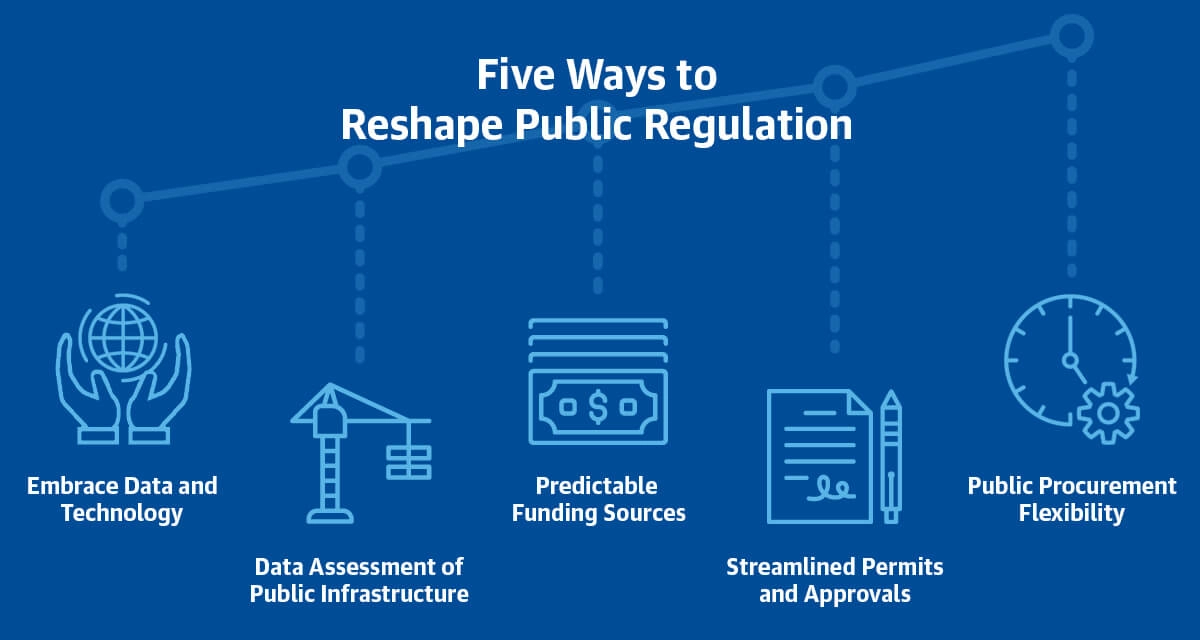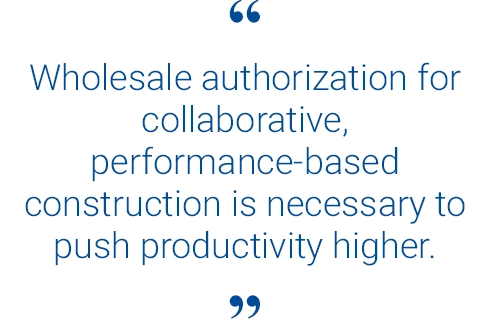Reshaping the Regulatory Environment to Improve Construction Productivity
September 9, 2020
Renowned global management consulting firm, McKinsey & Company, is all about helping its clients make performance improvements and increase productivity to achieve desired outcomes. The firm’s McKinsey Global Institute (MGI) steps back from specific clients to look at the macro-economic environment by providing research and analysis about the global economy related to performance and productivity. For the record, I have no relationship or interest in McKinsey, but I do have a deep interest in fact-based analysis of policy issues at the nexus of construction and government. MGI hit the mark on these issues in its report: Reinventing Construction: A Route to Higher Productivity, released last year.
Paraphrasing the report findings, the construction industry has a big productivity problem: It lags far behind other industries in productivity growth over time, and government regulation is one of the root causes for this lag.
Governments are unique actors in construction, often playing three parts—buyers, regulators and enforcers. For our purposes here, let’s focus on governments as regulators. If construction productivity is to experience the type of growth other industries, such as manufacturing, have experienced, government regulation needs to evolve. Below are some changes governments—and governments alone—could make to add enormous productivity to the construction industry.
Embrace data and technology
Some governments still require construction bids to be delivered on paper. In many cases, public work bid solicitations must be published in print newspapers. I haven’t mailed a check to pay for a single home service (electric, internet, propane delivery, etc.) in years, yet our construction statutes still require paper. Fixing this is low-hanging fruit.
Further, allowing the use of electronic record-keeping for permits, approvals, bid documents, certified payrolls and more would add instant productivity for the construction industry.
Governments also need to stop creating what already exists in the marketplace. The construction industry has high-value commercial, off-the-shelf data and software to support government planning, estimating, design and construction. Government regulators at all levels should be demanding this approach, instead of “create it from scratch” approaches that shift valuable funds away from completing construction work to risky data creation and software development and the ongoing upkeep they require.
Use data to assess public infrastructure needs
Too often, governments make funding choices based on anecdotal information. But objective data about the lifecycle of infrastructure and facilities—and the systems that support them—are available to governments.
Impartial analysis thwarts politically-driven decisions, and longitudinal data allows for better prediction of needs over time to drive project prioritization. The data becomes a telescopic window for planning from routine maintenance to major projects.
Applying modeling and predictive analytics to generate 5D building information (three dimensions, plus time and cost) would allow governments to see both needs and costs far enough in advance to plan and fund. This would allow the construction industry to prepare to respond to pending needs.
Objective, benchmarked data must become the basis for funding decisions by governments.
Predictable funding for public construction
If public construction funding sources and spending intentions are known and consistent, construction industry businesses can plan ahead. While the public construction marketplace is less cyclical than the private marketplace, it is often still dependent on annual appropriations and subject to possible government shutdowns. Governments need to plan and fund construction over longer durations and not wait until the last minute to update project lists and extend funding.
Consistency and predictability of funding and spending not only add certainty for public construction enterprises, but also allow private-sector developers and construction-related businesses to plan over a longer term. Known and assured public improvement projects drive the private development that follows public improvements. Better roadways, transit service and water infrastructure are all critical components of any private developer’s assessment about where and when to invest.
Streamlined permitting and approvals for all construction
Intelligent planning focuses construction in the right places. But, it takes significant time and steady effort to bring all the stakeholders together and settle on regional plans. While local planning and zoning are important, state governments can drive holistic visions and provide the certainty that developers require.
Once construction is planned for designated places, then governments need to streamline the review process for individual projects. Set clear, unambiguous requirements to obtain each approval and process reviews quickly. Developers can absorb costs for approvals to build, if the rules don’t change in the middle of the game, but delays kill construction productivity. Certainty and speed during the governmental review process would drive productivity upward.
Public construction procurement flexibility
In the United States, statutory requirements for public construction procurement at the state level were largely created a century ago or longer, as in certain eastern states. Updates often have been piecemeal and resulted in only minor adjustments to the status quo. These statutes require wholesale reconstruction, as executive department regulators cannot create flexibility for construction procurements if the statutory framework is rigid.
The traditional “design-bid-build” process is slow and costly. It consumes enormous administrative time, and worse, it pits the owner against the contractor, against the designer. Legislative authorizations for forms of integrated project delivery, such as design-build and job order contracting, are becoming more common, but they often come with restrictions driven by special interests protecting the old and under-productive approaches. Wholesale authorization for collaborative, performance-based construction is necessary to push productivity higher.
Legislatures around the country should also be eliminating certain public construction procurement practices that permit negotiated prices or “three-quotes” contractor selection. These practices are ripe for corruption. As the McKinsey report noted, informality and corruption are tied. For small renovations and repairs, for which three-quotes contractor selection is often the norm, shifting to competitively-awarded, on-call construction contracts based on firm cost data would yield both efficiency and transparency—a natural corruption preventative.
Other antiquated approaches to public construction buried in statute include designing every project from scratch and completing design work simply to create documents for construction bidding purposes. Construction productivity would jump by simply undertaking design and cost estimation based on existing models, assemblies and standard design elements, focusing the industry’s talented architects, engineers and estimators on the creative and nuanced work of the professions instead of the grunt work. Legislatures around the country need to loosen the laws that require every project to have an architect or engineer prepare formal construction bidding documents.
The Takeaway
The solutions to the construction industry’s productivity problem are not limited to the approaches itemized above. Embracing technology, using data to drive decisions, creating predictable funding sources, streamlining permitting and approvals and bringing flexibility to public procurement would significantly boost construction productivity, while yielding enormous benefits for taxpayers.
Share this:








